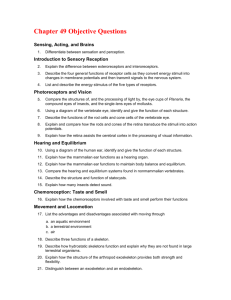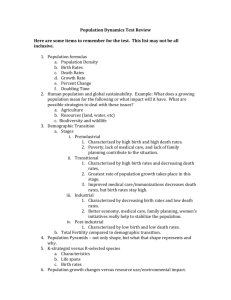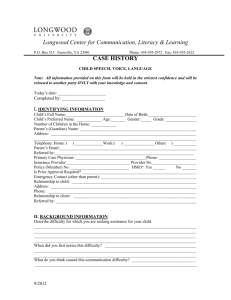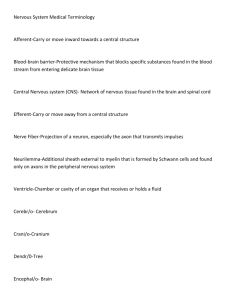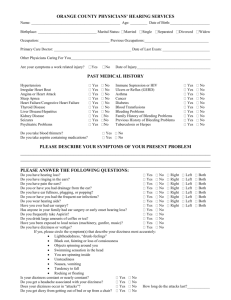Medical Terminology
advertisement
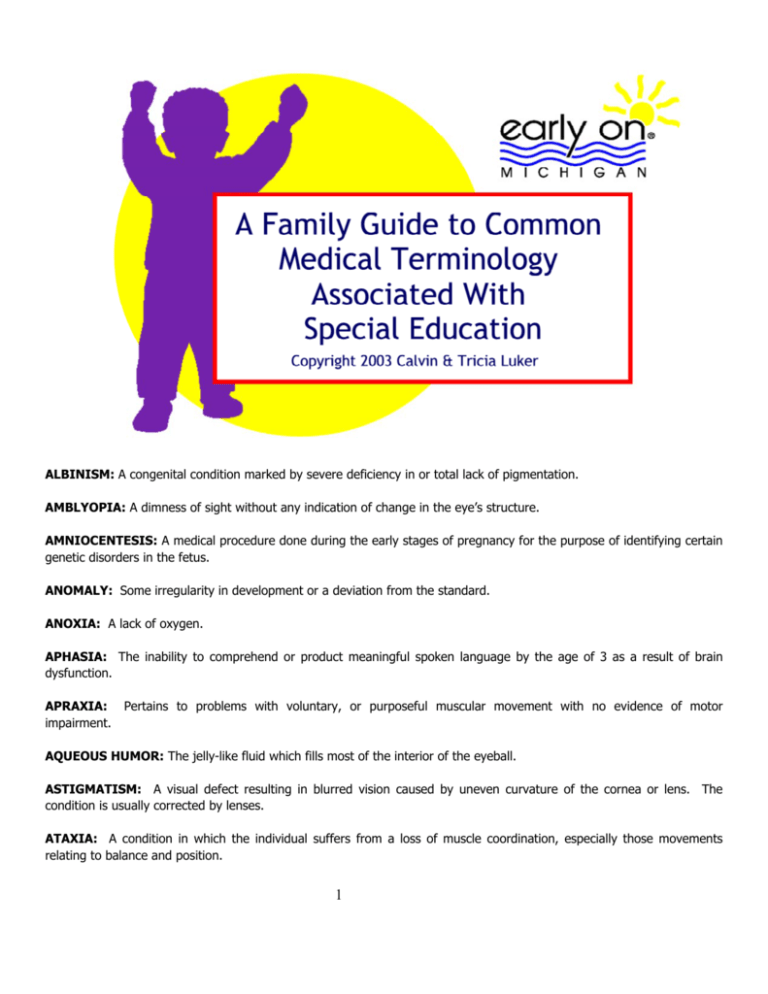
ALBINISM: A congenital condition marked by severe deficiency in or total lack of pigmentation. AMBLYOPIA: A dimness of sight without any indication of change in the eye’s structure. AMNIOCENTESIS: A medical procedure done during the early stages of pregnancy for the purpose of identifying certain genetic disorders in the fetus. ANOMALY: Some irregularity in development or a deviation from the standard. ANOXIA: A lack of oxygen. APHASIA: The inability to comprehend or product meaningful spoken language by the age of 3 as a result of brain dysfunction. APRAXIA: impairment. Pertains to problems with voluntary, or purposeful muscular movement with no evidence of motor AQUEOUS HUMOR: The jelly-like fluid which fills most of the interior of the eyeball. ASTIGMATISM: A visual defect resulting in blurred vision caused by uneven curvature of the cornea or lens. The condition is usually corrected by lenses. ATAXIA: A condition in which the individual suffers from a loss of muscle coordination, especially those movements relating to balance and position. 1 ATHETOSIS: An abnormal movement characterized by involuntary, jerky, purposeless, and repetitive movements of the extremities, head, and tongue. ATROPHY: The degeneration of tissue. AUDIOGRAM: A graphic representation of the results of a hearing test. AUDIOLOGIST: A specialist trained in the evaluation and remediation of auditory disorders. BINOCULAR VISION: Vision using both eyes working together to perceive a single image. BLIND, LEGALLY: Visual acuity measured at 20/200 in the better eye with best correction of glasses or contact lenses. Vision measured at 20/200 means the individual must be 20 feet from something to be able to see what the normal eye can see at 200 feet. CATARACT: A condition of the eye in which the crystalline lens becomes cloudy or opaque. As a result, a reduction or loss of vision occurs. CATHETER: A tube inserted into the body to allow for injections or withdrawal of fluids or to maintain an opening in a passageway. CEREBRAL PALSY: Refers to an abnormal amount of human movement or motor functioning resulting from a defect, insult, or disease of the central nervous system present since birth. COCHLEA: Referred to as the organ of hearing, this part of the ear is responsible for sending impulses to the brain. CONDUCTIVE HEARING LOSS: A hearing loss resulting from obstructions in the outer or middle ear or some malformations that interfere in the conduction of sound waves to the inner ear. This condition may be corrected medically or surgically. CONGENITAL: Present at birth. CRETINISM: A congenital condition associated with a thyroid deficiency that can result in stunted physical growth and mental retardation. CYANOSIS: A lack of oxygen in the blood characterized by a blue discoloration of the skin. CYSTIC FIBROSIS: An inherited disorder affecting the pancreas, salivary, mucous, and sweat glands that causes severe, long-term respiratory difficulties. DIPLEGIA: Paralysis that affects either both arms or both legs. DOWN’S SYNDROME: A medical abnormality caused by a chromosomal anomaly which often results in moderate to severe mental retardation. The child with Down’s Syndrome will exhibit certain physical characteristics such as a large tongue, heart problems, poor muscle tone, and broad, flat bridge of nose. ELECTROENCEPHALOGRAM (EEG): A graphic representation of the electrical output of the brain. ENCOPRESIS: A lack of bowel control that may also have psychological causes. 2 ENDOGENOUS: Originating from within. ENURESIS: A lack of bladder control that may also have psychological causes. EXOGENOUS: Originating from the environment outside the body. FETAL ALCOHOL SYNDROME: A condition usually found in the infants of alcoholic mothers. As a result, low birth weight, severe retardation, and cardiac, limb, and other physical defects may be present. FIELD OF VISION: The area of space visible with both eyes while looking straight ahead; measured in degrees. GLAUCOMA: An eye disease characterized by accessibility high pressure inside the eyeball. If untreated, the condition can result in total blindness. GRAND MAL/GENERALIZED SEIZURE: A form of an epileptic seizure in which the individual exhibits violent convulsions, loses consciousness, and becomes rigid. HEMIPLEGIA: Paralysis involving the extremities on the same side of the body. HEMOPHILIA: An inherited deficiency in the blood-clotting factor which can result in serious internal bleeding. HERTZ: A unit of sound frequency used to measure pitch. HYDROCEPHALUS: A condition present at birth or developing soon afterwards from excess cerebrospinal fluid in the brain and resulting in an enlargement of the head and mental retardation. This condition is sometimes prevented by the surgical placement of a shunt which allows for the proper drainage of the built up fluids. HYPERACTIVITY: Excessive physical and muscular activity characterized by extreme inattention, excessive restlessness, and mobility. The condition is usually associated with Attention-Deficit Disorder or learning disabilities. HYPEROPIA: Farsightedness; a condition causing difficulty with seeing near objects. HYPERTONICITY: Refers to heightened state of excessive muscle tension. HYPOTONICITY: Refers to an inability in maintaining muscle tone or an inability in maintaining muscle tension or resistance to stretch. INSULIN: A protein hormone produced by the pancreas that regulates carbohydrate metabolism. IRIS: The opaque, colored portion of the eye. JUVENILE DIABETES: A children’s disease characterized by an inadequate secretion or use of insulin resulting in excessive sugar in the blood and urine. This condition is usually controlled by diet and/or medication. However in certain cases, control may be difficult and if untreated, serious complications may arise such as visual impairments, limb amputation, coma, and death. MENINGITIS: An inflammation of the membranes covering the brain and spinal cord. If untreated can result in serious complications. 3 MENINGOCELE: A type of spina bifida in which there is protrusion of the opening of the spinal cord through an opening in the vertebrae. MICROCEPHALY: A disorder involving the cranial cavity characterized by the development of a small head. Retardation usually occurs from the lack of space for brain development. MONOPLEGIA: Paralysis of a single limb. MULTIPLE SCLEROSIS: A progressive deterioration of the protective sheath surrounding the nerves leading to a degeneration and failure of the body’s central nervous system. MUSCULAR DYSTROPHY: A group of diseases that eventually weakens and destroys muscle tissue leading to a progressive deterioration of the body. MYOPIA: Nearsightedness; a condition which results in blurred vision for distance objects. NEONATAL: The time usually associated with the period between the onset of labor and 6 weeks following birth. NEUROLOGICALLY IMPAIRED: Exhibiting problems associated with the functioning of the central nervous system. NYSTAGMUS: A rapid, rhythmic, and involuntary movement of the eyes. This condition may result in difficulty reading or fixation upon objects. OCULAR MOBILITY: Refers to the eye’s ability to move. OPTOMETRIST: A professional trained to examine eyes for defects and prescribe corrective lenses. OPHTHALMOLOGIST: A medical doctor trained to deal with diseases and conditions of the eye. OPTIC NERVE: The nerve in the eye which carries impulses to the brain. OPTICIAN: A specialist trained to grind lenses according to a prescription. OSSICLE: The three small bones of the ear that transmit sound waves from the eardrum. They consist of the malleus, incus, and stapes. OSTEOGENESIS IMPERFECTA: Also known as “brittle bone disease,” this hereditary condition affects the growth of bones and causes them to break easily. OTITIS MEDIA: Middle-ear infection. OTOLARYNGOLOGIST: A medical doctor specializing in diseases of the ear, nose and throat. OTOLOGIST: A medical doctor specializing in diseases of the ear. OTOSCLEROSIS: A bony growth in the middle ear which develops around the base of the stapes, impeding its movement and causing hearing loss. 4 ORGANIC: Factors usually associated with the central nervous system that cause a handicapping condition. PARALYSIS: An impairment to or a loss of voluntary movement. PARAPLEGIA: A paralysis usually involving the lower half of the body, including both legs. PERINATAL: Occurring at or immediately following birth. PETITE MAL/ABSENCE SEIZURES: A form of epilepsy characterized by a momentary lapse of consciousness. PHENYLKETONURIA: Referred to as PKU, this inherited metabolic disease usually results in severe retardation. However, if detected at birth, a special diet can reduce the serious complications associated with the condition. PHOTOPHOBIA: An extreme sensitivity of the eyes to light. This condition is common in albino children. POSTNATAL: Occurring after birth. PRENATAL: Occurring before birth. PROSTHESIS: An artificial device used to replace a missing body part. PSYCHOMOTOR SEIZURE: A seizure in which the person exhibits many automatic seizure activities of which he/she is not aware. PUPIL: The opening in the middle of the iris which expands and contracts to let in light. QUADRIPLEGIA: Paralysis involving all four limbs. RETINA: The back portion of the eye, containing nerve fibers which connect to the optic nerve on which the image is focused. RETINITIS PIGMENTOSA: A degenerative eye disease in which the retina gradually atrophies, causing a narrowing of the field of vision. RETROLENTAL FIBROPLASIA: An eye disorder resulting from excessive oxygen in incubators of premature babies. RH INCOMPATIBILITY: A blood condition in which the fetus has Rh-positive blood and the mothers has Rh-negative blood leading to a build-up of antibodies that attack the fetus. If untreated, can result in birth defects. RHEUMATIC FEVER: A disease characterized by acute inflammation of the joints, fever, skin rash, nosebleeds, and abdominal pain. This disease often damages the heart by scarring its tissues and valves. RIGIDITY CEREBRAL PALSY: A type of cerebral palsy characterized by minimal muscle elasticity, and little or no stretch reflex which creates stiffness. RUBELLA: Referred to as German Measles, this communicable disease is usually only of concern when developed by women during the early stages of pregnancy. If contracted at that time, there is a high probability of severe handicaps of the offspring. 5 SCLERA: The tough white outer layer of the eyeball which protects as well as holds contents in place. SCOLIOSIS: A weakness of the muscles which result in a serious abnormal curvature of the spine. This condition may be corrected with surgery or a brace. SEMICIRCULAR CANALS: The three canals within the middle ear that are responsible for maintaining balance. SENSORINEURAL HEARING LOSS: A hearing disorder resulting from damage or dysfunction of the cochlea. SHUNT: A tube that is inserted into the body to drain fluid from one part to another. This procedure in common is cases of hydrocephalus to remove excessive cerebrospinal fluid from the head and redirect it to the heart or intestines. SPASTICITY: A type of cerebral palsy characterized by tense, contracted muscles, resulting in muscular incoordination. SPINA BIFIDA OCCULT: A type of spina bifida characterized by a protrusion of the spinal cord and membranes. This form of the condition does not always cause serious disability. STRABISMUS: Crossed eyes. TREMOR: An involuntary trembling movement. TRIPLEGIA: Paralysis of three of the body’s limbs. USHER’S SYNDROME: A genetic disorder that may result in a combination of visual and hearing impairments. VISUAL ACUITY: Sharpness or clearness of vision. 6
